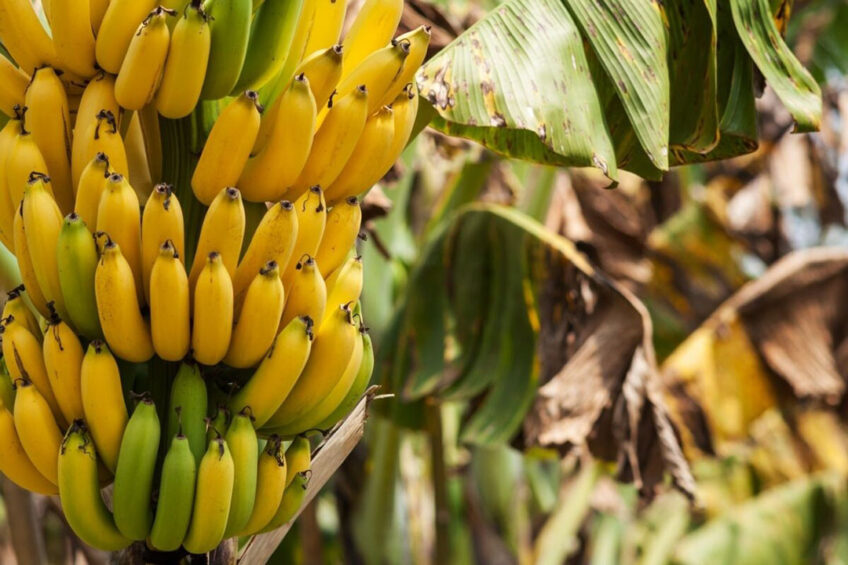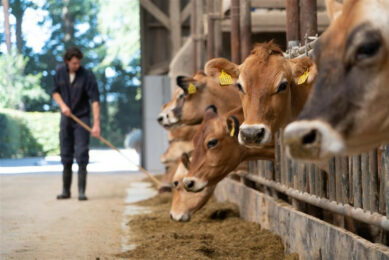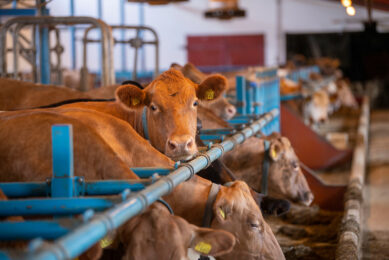Banana peels as silage for ruminants

Bananas constitute one of the most important, year-round staple food crops for human consumption in most African countries. It generates considerable quantities of banana peels, part of which is frequently used as feed resources in livestock production. Banana peels as silage for ruminants is, therefore, an interesting consideration.
Nutritive value of banana peels as silage
Banana peels have numerous positive attributes, making them suitable as animal feed and as an alternative complementary feed during periods of forage shortage. They have high moisture content (around 15% DM), which helps animals to stay hydrated.
Banana peels are also a good source of minerals, especially potassium and sodium, and have a fibre content of around 30% compared to the fibre content of around 45% in most grass species. This gives the peels an improved digestibility and subsequently an elevated intake compared to those of grasses (60.6% digestibility of DM and 58.6% digestibility of organic matter). They also contain various types of vitamins such as A, B1, B2, and C, and are extremely rich in harmless starch, which is impervious to α-amylase and gluco-amylase because of its high level of crystalline characteristic structure.
Further, banana peels have been reported to contain high tannin contents. Feeding tannin-containing feeds results in meat with a lighter colour and tend to increase milk yield and protein content, probably because they protect the dietary protein from rumen degradation. In addition, they provide sufficient amounts of glucose, which is fundamental for the upkeep and beneficial capacities in ruminants.
The potential use of banana peels as silage
The basic principles of silage made from banana peels are the same as silage made from forage. Thus, the peels should be kept under anaerobic conditions and remain in airtight storage to encourage lactic acid fermentation where the free sugars are converted to lactic acid, which lowers the pH and inhibits pH-sensitive microorganisms to spoil the silage. A rise in pH above 4.7 may be a consequence of undesirable microbial activity, such as the growth of clostridia that degrade the nutritional value of the silage while producing high levels of butyric acid, acetic acids, and ammonia, all of which affect the quality of silage and therefore animal performance.
Chopping of the banana peels should be done before putting them in the silo. Doing that can contribute to improving an airtight environment since a more compact material excludes air more effectively. Secondly, chopping would favour the fermentation process, since a shorter chopping length enhances the availability of the energy for the microorganisms. However, as banana peels are poor in free sugars, and as easily fermentable carbohydrates are of the highest concern to achieve a rapid lowering of pH, they should be mixed with energy-rich materials, e.g. molasses or root crops.
Banana peels could also be mixed with dry feeds since extremely wet silage (DM <25%) can lead to undesirable fermentation and result in with sour silage. Furthermore, in tropical conditions where high temperatures are common, spoilage during feed-out is of great concern. The farmers should therefore consider constructing smaller trenches so that the feed can be fed out in a short time, thereby minimising aerobic spoilage.
The ensiling period for silage prepared from raw banana peels without any additives is 28 days, but with 3% jaggery (unpurified or non-centrifugal sugar) the ensiling period may not exceed 24 days. Raw banana peel silage with jaggery as an additive in the specified ensiling period will have desirable characteristics in terms of colour, odour, and spoilage compared to other additives such as salt or urea (Table 1).
Animal production
In dairy cattle feeding, it was noted that live weight did not significantly differ when banana peels were fed to dairy cows at 20, 40, and 60% level of daily ration and supplemented with maize bran and cottonseed cake, to make them iso-nitrogenous. Banana peels also have a positive effect on milk production due to the supply of a sufficient amount of glucose, as indicated earlier. A lactating dairy cow needs a good supply of glucose due to the demands for milk synthesis.
The greatest limitation to using bananas is the lack of fermentable nitrogen. This situation was clarified by an experiment comparing banana diets fed with and without cottonseed cake to cattle. As shown in Table 2, significant improvements in ADG were obtained with supplementation. Such improvements have occurred linearly as the level of cottonseed cake increased from 1 to 2 kg/cow/day.
Such banana waste can also be used in the fresh or ensiled form as an alternative feed for lambs fed grass forage. In one study, no significant differences in total DM intake, total digestible energy intake, total body weight gain, and daily gain were noted between the two groups of lambs fed either banana peels or ryegrass.
For lactating goats, a study was also conducted to examine the possibility of substituting the cereal component in the diet of lactating goats with either green or ensiled banana peels. It was found that complete replacement of the cereals with banana peels resulted in increased dry matter intake and significantly higher milk yield and feed efficiency (Table 3).
Conclusions
• Banana peels can be used as a valuable silage material and are recommended for areas of high banana production and processing.
• Banana peels as silage can be successfully conserved when typical ensiling conditions are provided and a proper additive is used.
• The crude protein content of banana peels is usually low (around 8% of DM). Although the peels are rich in potassium and sodium, they lack other elements such as calcium and phosphorus. These elements should, therefore, be supplemented along with protein-rich sources for optimal animal performance.
• Proper handling, supplementation, and feeding of silage made of banana peels would have positive effects on cattle, sheep, and goats in terms of growth and milk production.
References are available from the author upon request.
Join 13,000+ subscribers
Subscribe to our newsletter to stay updated about all the need-to-know content in the dairy sector, two times a week.










